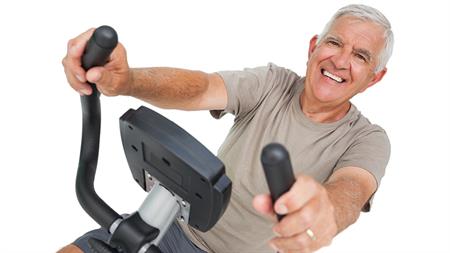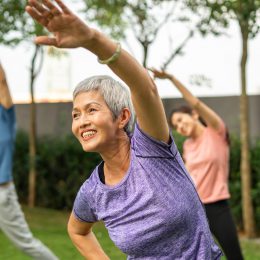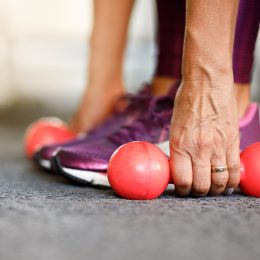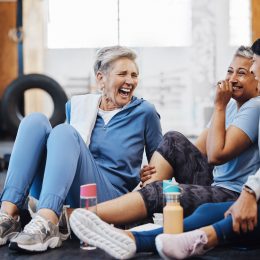Joint pain? Try this 5 day workout plan

Ouch!
We’ve all felt it at some time in our lives: joint pain.
Whether we have been diagnosed with arthritis, fibromyalgia, or we just call them “common aches and pains,” joint discomfort impacts just about everyone at some time or another.
The pain can be severe. In some cases it can be debilitating. But for many of us, aching joints are simply a nuisance that can make everyday activities into uncomfortable challenges. This nuisance, like so many in life, can be overcome with a plan. An exercise plan.
Can exercise alleviate joint pain?
The short answer is yes. But you may want to discuss your symptoms with a medical professional before you start any kind of exercise plan. If you get the OK from your doctor and you decide to use exercise for joint pain relief, know this: Science is on your side.
According to a Harvard University Medical School article, “The secret to joint pain relief — exercise,” getting moderate exercise can lead to lasting relief from joint pain: “the right set of exercises can be a long-lasting way to tame ankle, knee, hip, or shoulder pain. Practiced regularly, joint pain relief workouts might permit you to postpone — or even avoid — surgery on a problem joint that has been worsening for years by strengthening key supportive muscles and restoring flexibility.”
Additionally, the Centers for Disease Control and Prevention advocate physical activity to relieve the symptoms associated with arthritis. Their “Arthritis Basics” tip sheet says, “physical activity can reduce pain and improve function, mobility, mood and quality of life for most adults with many types of arthritis.”
Whether you have arthritis or not, if joint pain is impacting your life, the right exercises may help. Try these in the 5 day workout for aching joints.
- Day 1: Walking
- Day 2: Bicycling
- Day 3: Aquatic exercise
- Day 4: Weight training
- Day 5: Tai chi or yoga
How will these exercises relieve my joint pain? Where can I do these exercises? What the heck are some of these exercises? Read on.
Joint pain relief Day 1: Walking
Experts suggest walking for at least 30 minutes per day. But even if you can only walk for five to 10 minutes at a time, you will still get the benefits of gently boosting your heart rate, improving circulation and strengthening muscles. By taking several short walks throughout your day, you can accumulate the full 30 minutes recommended. These walks can help you lose or maintain your weight.
Being overweight is often a significant contributor to joint pain. But even if you are at your ideal weight and still confront joint pain, walking can build muscles. Stronger muscles relieve tendons and ligaments of the pressure that contributes to joint pain and other persistent aches. Walking is a low impact activity that can keep joints and muscles limber.
Walk on the treadmill at your gym or other fitness location, take a walk outdoors or, if the weather is unpleasant, make your way to a nearby mall or other large public space, enjoy the air conditioning and get your steps in. You may also consider investing in a pedometer or step-tracker. These allow you to record the number of steps you take, measure your progress and challenge yourself with specific and quantifiable goals.
The National Institutes of Health (NIH) recommends getting 8,000 steps per day. If you aren’t getting that many yet or that seems daunting, start gradually and try to add 500 steps each day until you reach the goal. If you are getting more than 8,000 steps already, aim for 10,000. If you are getting more than that, great job. Keep challenging yourself to do even more.
Whether or not you want to invest in a pedometer or step-tracker, you should consider investing in a good pair of exercise shoes. There are many athletic shoes designed specifically for walking, but running shoes or tennis shoes will work as well. Regardless of the shoes you get, make sure they are sturdy and comfortable. Additionally, consider finding a walking buddy.
For just about any exercise plan, having a partner can make sticking with a routine much more likely and much more fun. With a walking buddy, you will have someone to inspire and someone who will inspire you. Many people find that a four-legged friend is exactly what they need to get them moving. Whether you walk on your own, walk with another person or take your dog for a stroll, make a specific goal for Day 1 of this exercise plan. Aim for a certain number of steps or try to walk for a certain amount of time.
Joint pain relief Day 2: Bicycling
If you live in a community that is bike friendly, get into the bike lane or get onto the path. Depending on your fitness level or the amount of joint pain you are experiencing, adjust the challenge of your ride.
As with walking, start slow and increase the distances as you get more comfortable with the challenge. Also, make sure to plan ahead. Are you a mountain biker? Or do you prefer a ride through the streets? Determine how far you want to ride, how long the ride might take and what elevation changes might be involved. Traffic, weather and other variables should also be considered.
Consider these alternatives as well:
- Upright stationary bike
- Recumbent stationary bike
- A group cycling class at a gym
If you don’t own a bike, or you prefer the gym for your exercise, or you are considering purchasing fitness equipment for your home, a stationary bike may be attractive. If a traditional stationary bike contributes to your pain or you are not comfortable on one, a stationary recumbent bike may be better.
Recumbent bikes allow you to sit lower to the ground, and they position the pedals in front of you while also providing a back cushion for support and comfort. The seating position may alleviate pressure on your back joints if that is an area of concern. These types of bikes also put less pressure on knee and hip joints, compared to upright bicycles.
Another option involves taking a cycling class at a gym. Chances are good there is at least one gym in your community that offers a cycling class.
These cycling classes — often called “spin” classes — usually last an hour and allow participants to burn hundreds or even thousands of calories during the workout. The bikes in the classes are upright bikes and are specifically designed for smooth pedaling, which takes some of the burden off of sore joints in the legs. These bikes also allow the rider to easily control the amount of resistance on the pedals.
A “spin” instructor directs the class to alter the resistance from low to high and alters the pace throughout. Upbeat music and an encouraging environment are hallmarks of most spin classes, and the degree of difficulty is determined by each rider: Every rider controls the resistance on his or her own bike!
Like nearly all group fitness classes, the pace of a cycle class can be as intense or as moderate as you like. Also, like nearly every group fitness class, participants encourage and inspire one another.
Bicycling increases range of motion in aching joints, increases muscle strength in legs and improves cardiovascular health. The aerobic benefits of cycling also aid in weight control. So, as an alternative to high-impact aerobics classes or running, bicycling is a gentler way to get the same benefits of some other exercises that are not-so-joint-friendly.
Joint pain relief Day 3: Aquatic exercises
Exercising in water is often the best form of activity for people with severe joint pain. Water-based exercises can build strength, develop cardiovascular health, increase flexibility, improve balance and can also aid in weight control. This almost sounds too good to be true, but it gets better:
- Because buoyancy in the water combats gravity, many people with joint pain and arthritis can get the benefit of exercises that they may not be able to perform on dry land.
- People who use a walker, cane or wheelchair can add flotation belts or similar equipment to exercise in the water without fear of losing balance. Jogging in place and high kicks, for instance, may be impossible on land for many people. In the water, however, these types of activities can be accomplished.
- The water offers resistance but also support.
- If you don’t consider yourself a strong swimmer, don’t worry. Many aquatic exercises take place in water that is only waist deep. Many require no swimming at all.
If you are comfortable doing the breast stroke, back stroke, butterfly or freestyle, by all means get in the pool and do some laps. Even 10 minutes of swimming per day can have a tremendous impact on strength, flexibility, weight control and joint pain relief. But don’t feel obligated to swim laps or do your Michael Phelps impression.
Opportunities to get an aquatic workout abound, and most of those opportunities do not involve laps. There is likely at least one gym or athletic facility in your community that has a pool and offers aquatic exercise classes.
In recent years, aquatic exercise classes have become increasingly popular for people of all ability levels. Handheld weights, resistance bands and other “gym” equipment have been integrated into many aquatic exercise classes. These offer the safety of the water while also promoting a great workout.
Regardless of what you choose to do in the water — laps on your own, body surf in the ocean, or take an aquatic class at your gym — remember that exercise in the water is great no matter who you are. It may be particularly appealing if you suffer from aching joints.
Joint pain relief Day 4: Weight training
That’s right: Pumping iron can help with joint pain. Stronger muscles offer more support to weak or damaged joints. This support can take pressure off those aching joints. Additionally, lifting weights can increase your pain threshold and increase stability.
You do not have to be a bodybuilder to benefit from weight lifting. Light and moderate dumb bells are plenty for most of us. Free weights are fantastic, but you may also utilize the weight machines at your gym. Many times, these machines offer support for your back and legs and can take pressure off of knees and hips. Another bonus of weight machines: They typically include diagrams showing how to use the machines and what muscle groups are targeted by the exercise.
Weight training can lead to sore muscles, but this is not necessarily negative. You should not weight train the same muscles every day, because muscles typically need at least 48 hours to recover from weight training.
Subscribe to our newsletter
It's quick and easy. You could be one of the 13 million people who are eligible.
Already a member? Click to discover our 15,000+ participating locations.
Follow Us
Furthermore, if you are feeling pain in joints or bones, you may want to check your weight lifting form and/or reduce the amount of weight you are using. Soreness, however, is not the same as injury.
After a few weeks of exercising your muscles a few times a week, you will notice that the soreness will not be so severe. A bit of muscle soreness may indicate that you are building muscle and challenging yourself to increase your strength. But what weight training exercises should you do?
The answer is dependent on your goals. It is also dependent on the joint pain severity and location. You may want to discuss your aching joints with a doctor, physical therapist or trainer who has a background in adaptive exercise. These experts may be able to offer a very specific weight training plan that can lead to joint pain relief.
Whatever weight training exercises you do, keep these general tips in mind:
- Use light weights and aim for high repetitions. This approach may be easier on your joints while also providing toned and lean muscles. Heavier weights may lead to bulky muscles and may also be more challenging to your joints.
- Instead of using dumbbells and barbells, use weight machines.
- Try doing two or three sets of a weight training exercise: using light weight, try 15 repetitions, take a 30 second break, then repeat until you’ve done three sets of 15.
- Aim for 20-30 minutes of weight training especially if you have never done weight lifting. Increase the number of exercises and repetitions at your own pace.
As with all exercises, listen to your body. After a workout, determine if your pain is normal muscle soreness or actual injury. While muscle soreness is a sign that you are challenging yourself, back off the weight if you believe the pain is something more serious and talk to a trainer, physical therapist or doctor.
Joint pain relief Day 5: Tai chi or yoga
Why practice tai chi or yoga if you have joint pain?
- These exercises are low impact and extremely safe. The movements in both tai chi and yoga are slow and put very little stress on joints compared to many other forms of exercise.
- Both practices encourage body awareness and allow for many adaptations based upon physical ability and degree of joint pain.
- Improvements in range of motion, flexibility and balance are all goals of both tai chi and yoga.
What is tai chi? Tai chi is often called “moving meditation” because the practitioner is encouraged to focus on their breathing and to maintain a calm demeanor. They move into different forms that resemble slow motion martial arts moves. These gentle movements offer stimulation for the entire body and may lead to increased stamina, range of motion, muscle strength, stability and flexibility.
What is yoga? Yoga combines physical postures, deep breathing, meditation and relaxation methods to improve muscle strength, flexibility, balance and range of motion while also reducing stress. As with weight training, many yoga postures strengthen muscle, which can take pressure off of sore joints.
Both forms of exercise have been practiced for thousands of years. Their benefits are quite clear in the countries from which they emerge — China and India, respectively — and modern scientific studies suggest people with joint pain may benefit from practicing tai chi and yoga.
The National Center for Complementary and Integrative Health reports that “tai chi may help people manage chronic pain associated with knee osteoarthritis and help people with fibromyalgia sleep better and cope with pain, fatigue, and depression.” The NCCIH also states that “a carefully adapted set of yoga poses may reduce low-back pain and improve function.” Furthermore, people who practice yoga also report better overall well-being and health compared with those who don’t practice yoga.
In the TIME Magazine article “How Yoga Can Help People With Arthritis”, the reporter cites a medical study showing that “people with arthritis who practice yoga reap impressive physical and mental benefits. Those who practiced yoga three times a week had an improvement in pain levels, energy, mood and physical health” compared with a group of people with arthritis who did not practice yoga.
Harvard Medical School also has reported on the health benefits of tai chi. The practice “supports or improves balance, coordination, flexibility, muscle strength, and stamina.” Furthermore, tai chi has been shown to relieve chronic pain for people suffering from “osteoarthritis, rheumatoid arthritis, fibromyalgia, tension headache, and other ongoing, painful conditions.”
Of course, not all yoga exercises or tai chi moves are right for everyone, but there is a tremendous amount of variation in each for all ability levels. These practices are meant to be relaxing and invigorating for people of all athletic abilities.
Some forms of yoga can be fast-paced and intense. Some of the poses can be extremely challenging. And tai chi can be used as a form of self-defense when the forms are done forcefully and quickly (called tai chi chuan). However, both practices are adapted for all levels of fitness and ability.
If you suffer from joint pain or you have never practiced yoga or tai chi, find a class and an instructor that’s right for you and embrace the benefits of these gentle exercises to improve flexibility, range of motion and strength.
Reflecting on exercise and joint pain
If you have joint pain, you know the catch 22: joint pain can make moderate exercise extremely challenging, but moderate exercise is the prescription for relief. Lack of exercise may cause weight gain, stiffness, muscle atrophy and increased joint pain. Vitamins, supplements, prescription drugs, pain killers and massage and acupuncture may offer relief. But these may all be short-term solutions. Long-term joint-pain relief requires a different approach. The 5 day workout plan may be a part of the prescription you need.





